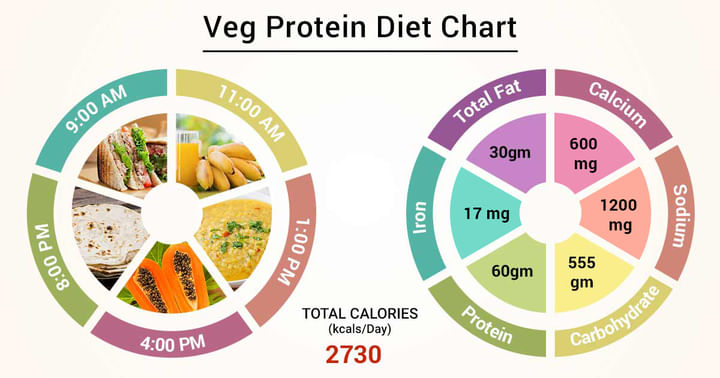Diet Chart For veg protein
Last Updated: Jan 20, 2025
About
A veg protein diet in India is not hard to procure. It is a misconception that meat is the biggest source of protein when several legumes have just as much protein content. Chickpeas, kidney beans, and milk are heavily loaded with it. Typical Indian food items such as cottage cheese (paneer) and lentils (dal) have been bet on by several dieticians. Whole grains and nuts complete the amino acid needs of our body. When it comes to vegetables, peas and spinach are the go-to product for a dose of tasty proteins. Soya chunks or quinoa are some unique food products that have the muscle-building nutrient in ample quantities. For the adventurous foodie, amaranth, hemp seeds, and chia seeds are also protein-rich.
Proteins help in cell regeneration and improve muscle density. Its intake also leads to natural weight loss since hunger impulses are reduced and satiety is increased. There are several ways to consume proteins for maximum retention. Following a veg protein diet is not synonymous with limited options. Dhokla, chhole, rajma and even chana chaat are delicious Indian dishes that are high in protein. For someone interested in global cuisine, tofu is a must-have ingredient. Avocados and black beans when added to a meal increase the protein percentage greatly. Hummus, made from chickpeas, is also a versatile addition to any meal.
Diet Chart
| Sunday | |
| Breakfast (8:00-8:30AM) | Cheese sandwich(4 slice bread) + 1 cup skimmed milk. |
| Mid-Meal (11:00-11:30AM) | 1 Ripe Banana |
| Lunch (2:00-2:30PM) | Chapati (3) + Masoor Dal (1 cup) + 2 Roasted Papad + 1/4th Fresh Lime + Cabbage curry (1 cup) |
| Evening (4:00-4:30PM) | Ripe Papaya (1 cup) |
| Dinner (8:00-8:30PM) | Chapati (2) + Potato n Drumstick curry (1/2rd cup) |
| Monday | |
| Breakfast (8:00-8:30AM) | chapati-2+ Paneer sabji 1 cup |
| Mid-Meal (11:00-11:30AM) | Fruit Salad (1 cup) |
| Lunch (2:00-2:30PM) | Chapati (3) + Arhar Dal (1 cup) + 1/4th Fresh Lime + Fried Badi (1/3rd cup) + Pumpkin n Potato Curry (1 cup) |
| Evening (4:00-4:30PM) | Soy Milk (1 cup) |
| Dinner (8:00-8:30PM) | 2 Chapati + Mix Veg. (1/3rd cup) |
| Tuesday | |
| Breakfast (8:00-8:30AM) | Uthappam 2 +Tomato /green chutney + 1 glass skimmed milk. |
| Mid-Meal (11:00-11:30AM) | Fruit Salad (1 cup) |
| Lunch (2:00-2:30PM) | Chapati (2) + Rajma (1 cup) + 1/4th Fresh Lime + Salad (1 serve) |
| Evening (4:00-4:30PM) | Cottage Cheese with 1/2 tsp Honey (1/2 cup) |
| Dinner (8:00-8:30PM) | Mashed Rice (1/2 cup) + Milk (1/3rd cup) + Jaggery (2 tsp) |
| Wednesday | |
| Breakfast (8:00-8:30AM) | Paneer Paratha 2 + 1 tbs green chutney. |
| Mid-Meal (11:00-11:30AM) | 1 Ripe Banana |
| Lunch (2:00-2:30PM) | Chapati (3) + Masoor Dal (1 cup) + 2 Roasted Papad + 1/4th Fresh Lime + Cabbage curry (1 cup) |
| Evening (4:00-4:30PM) | Ripe Papaya (1 cup) |
| Dinner (8:00-8:30PM) | 2 Chapati + Baked Beetroot n Carrot (1/3rd cup) |
| Thursday | |
| Breakfast (8:00-8:30AM) | Aloo Paratha 2 + Tomato chutney |
| Mid-Meal (11:00-11:30AM) | Fruit Salad (1 cup) |
| Lunch (2:00-2:30PM) | Chapati (3) + Arhar Dal (1 cup) + 1/4th Fresh Lime + Fried Badi (1/3rd cup) + Pumpkin n Potato Curry (1 cup) |
| Evening (4:00-4:30PM) | Cottage Cheese with 1/2 tsp Honey (1/2 cup) |
| Dinner (8:00-8:30PM) | Parboiled Rice (1/2 cup) + Carrot n Beetroot Curry (1 cup) |
| Friday | |
| Breakfast (8:00-8:30AM) | Cheela with paneer filling- 2 |
| Mid-Meal (11:00-11:30AM) | Fruit Salad (1 cup) |
| Lunch (2:00-2:30PM) | Chapati (2) + Rajma (1 cup) + 1/4th Fresh Lime + Salad (1 serve) |
| Evening (4:00-4:30PM) | Soy Milk (1 cup) |
| Dinner (8:00-8:30PM) | Khichdi (1/2 cup) + Baked Potato (1/3rd cup) |
| Saturday | |
| Breakfast (8:00-8:30AM) | Chapati 3 + Tofu masala 1 cup. |
| Mid-Meal (11:00-11:30AM) | Fruit Salad (1 cup) |
| Lunch (2:00-2:30PM) | Chapati (2) + Paneer curry (1 cup) + Carrot n Cucumber Salad (1 serve) |
| Evening (4:00-4:30PM) | Cottage Cheese with 1/2 tsp Honey (1/2 cup) |
| Dinner (8:00-8:30PM) | 1.5 Chapati + Milk (1/3rd cup) + Jaggery (2 tsp) |
Food Items To Limit
- Hard Cheese
- Caeser Salad
- Vegetable Soups
- White Sugar
- French Fried
Do's And Dont's
Do's:
- Eat foods rich in, or fortified with, calcium
- Pair iron-rich foods with vitamin C
- Be mindful of protein: About 20% of your total calories should come from protein
Don'ts:
- Eat mostly processed sources of protein
- Think going veg is automatically making your diet healthier
- Get stuck in a diet rut
Food Items You Can Easily Consume
- Tofu
- Lentils
- Beans
- Nuts
- Grains
- Leafy Greens
- Dried Fruits
References
- Beilin LJ, Burke V. Vegetarian diet components, protein and blood pressure: which nutrients are important?. Clinical and experimental pharmacology and physiology. 1995 Mar;22(3):195-8. [Cited 30 June 2019]. Available from:
- Marsh KA, Munn EA, Baines SK. Protein and vegetarian diets. The Medical Journal of Australia. 2013 Oct 29;199(4):S7-10. [Cited 30 June 2019]. Available from:
- Protein in the Vegan Diet- Simply Vegan, 5th Edition, The Vegetarian Resource Group [Internet]. vrg.org 2019 [Cited 06 August 2019]. Available from:
Table of content
Find Dietitian/Nutritionist near me
Ask a free question
Get FREE multiple opinions from Doctors



